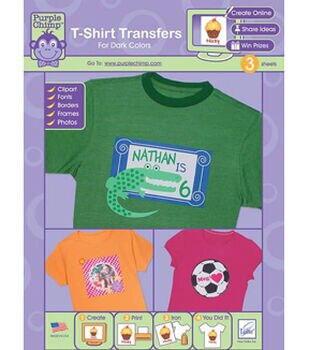T Shirt Iron On Programs To

Online shopping from a great selection at Software Store. Create your own iron-on transfers using an ordinary clothes iron, most software, and your inkjet printer. Model Number: AVE8938. Personalize T-shirts, tote bags, pillows and jackets with images, phrases, team names and anything you can imagine using Avery T-Shirt and Fabric Transfers. Great for personalized gifts,. Free t shirt iron on transfer software free download, free t shirt iron on transfer software freeware and shareware download. Applying an iron-on transfer to a t-shirt is a great way to personalize it with your own unique style Create your design transfer in any picture editing program or open a picture you wish to have on your shirt.
You can buy T-shirts with great designs already on them, and if you want a whole bunch of personalized shirts for a local drama club or church group, you can find shops that do shirts in bulk. However, if you want something original and maybe only one or two, do it yourself with an iron-on transfer. You can create your own custom clothing with absolutely no sewing skills. Decorate T-shirts, canvas bags and other fabric items with iron-on transfers that you design yourself on your computer and print on your desktop printer. What You Need Kits are available that give you everything you need, including and a T-shirt, or you can assemble your own materials.

Warriors Orochi 3.iso there. Whichever route you go, you need a few supplies for the typical iron-on style of transfer printed from your and applied with a household iron. • Software to design the T-shirt or other transfer • Artwork • • Printer • Iron • Hard surface for the iron • Pillowcase or other fabric • T-shirt or another item to receive the transfer Tips and Tricks When the instructions say you need a hot iron, they mean it. Here are a few tips and explanations to clarify the process of creating and applying iron-ons. • Print a preview. Always, always, always print a preview copy of your image before printing it on the (often expensive) transfer paper.
Do this to ensure that colors print correctly, that your image doesn't fall into your printer's no-print zone along the margins, and to see the actual size of the design —sometimes the on-screen view can be deceiving. • Flip the image. Don't forget to flip or mirror the image. This is especially critical if you have text in your design. Download Halford Resurrection Rar Free. The text should be backward on screen and on the printout. Another good reason to print a preview copy first! Some programs can flip the image for you.
• Use the right kind of transfer paper. If you have a laser printer, be sure to purchase transfer paper specifically for laser printers. Most T-shirt transfer paper is for inkjet printers. Transfer papers for white T-shirts is different from transfer paper for dark T-shirts. For example, the are for white and light-colored fabrics. Are specifically designed for dark-colored 100 percent cotton fabric.
Get the right kind of transfer paper for your printer and fabric. • Use the right side of the paper.
Transfer paper has stripes or some other design on the nonprinting side. Be sure to put the paper in your printer so that it prints on the clean white side. Not sure how to properly load your printer for transfer paper? Mark a plain sheet of paper then run it through to see which side comes out printed. • White does not print.
In designing your artwork remember that. The fabric shows through any parts of the design that are white. For example, if you print a white ghost on plaid fabric, you get a plaid ghost. Plan your design accordingly. As with any desktop publishing project, consider the background color when selecting colors for your designs. • Test on scrap fabric.
Test your design on scrap fabric of the same type and color before applying it to your final T-shirt or other fabric. Some types of fabric may require more ironing than others or may not show off your design as well as you expected. • Use lots of heat. Dubro Balancer Manual here. Use the hottest setting on your iron but no steam. It takes a lot of heat to transfer the image evenly and completely to the fabric. Peel off the paper while it is still hot unless you purchased cool-peel paper.
These newer transfer papers allow you to wait up to two minutes before peeling off the backing, so the paper is cooler to the touch. • Use a hard surface. The reason transfer instructions specify a hard surface is because it holds the heat. Ironing boards tend to disperse the heat and the transfer paper needs to be very hot to work properly. Protect the hard surface with a pillowcase. • Follow the manufacturer's instructions. Do what the paper manufacturer says.
The instructions may provide exact instructions for their specific paper on heat level, how long you should iron the transfer, and how long to wait before separating the paper from your fabric. Design Software You can use almost any graphics or creative printing program to design iron-on transfers artwork—as well as professional you already own. Ideally, the software will have an option to flip or reverse the image for transfer printing or you can manually flip the image in the document. However, there are some programs designed specifically for creating personalized iron-on transfers for T-shirts and similar projects. Many come with templates you can use to get you started.